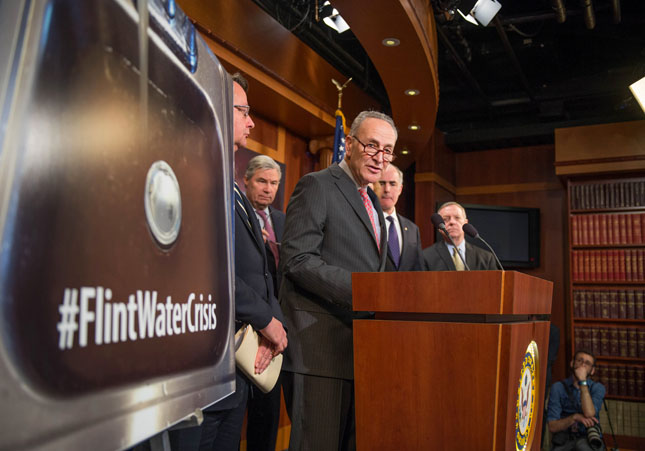-
Flint Offers Lessons on How Citizen Collaboration Can Hold Governments Accountable
April 21, 2016 By Louise Lief
A couple of weeks ago, the task force Michigan governor Rick Snyder appointed to investigate Flint’s now infamous water crisis issued its long-awaited report.
The findings detailed failures in multiple government agencies to address high levels of lead, a neurotoxin, in the city’s water. To cut costs, in the spring of 2014 Flint’s state-appointed emergency manager had switched the city’s water supply from Detroit’s system to the more polluted Flint River and kept it there, despite community protests, for 18 months.
Calling the crisis “a clear case of environmental injustice,” the task force issued 44 recommendations that will cost millions to implement. The long-term damage to many Flint children is irreversible.
The hidden success story in this disheartening tale of denial and indifference was the collaboration of an ad hoc coalition of journalists, citizens, and academics whose combined efforts finally compelled the state of Michigan to act. “Without their courage and persistence,” the report noted, “this crisis likely never would have been brought to light and mitigation efforts never begun.”
As New Jersey and Ohio have discovered, lead’s story doesn’t end in Flint. There are an estimated 10 million lead service lines in the U.S., part of the nation’s deteriorating water infrastructure that will require an estimated $1 trillion to rehabilitate.
As other communities wonder what perils they face, the Flint collaboration offers a road map on how to tackle environmental and other problems when government fails to act, especially for the most vulnerable communities.
Residents, Media, and Academia Converge
In an April 2 keynote address to the DC Science Writers Association, Curt Gayette, the investigative journalist hired by Michigan’s ACLU to look into residents’ complaints about Flint water, described the unusual collaboration. “All of us working together were able to achieve something that looked like it was unachievable – to go back to Detroit water, and to hold people accountable.”
In Flint, government institutions repeatedly denied there was a problem. Biased sampling underreported the prevalence of lead in the water and misreported children’s elevated lead levels. Emergency managers ignored residents’ complaints.
Contrary to reports that the media “missed” Flint, local reporters did their jobs. The SEJ Journal recounts how The Flint Journal and Detroit Free Press ran hundreds of stories on Flint’s water problems. Local radio covered it. But in the face of regulators’ assurances that test results showed the water was safe, they could not advance the story beyond a tale of “he said, she said.”
They needed independent evidence. The Flint story finally got national attention because citizens and academics did their own independent testing and created the data.
Their actions were born of desperation. Her children ailing, Flint mother Leeanne Walters reached out to Virginia Tech professor Marc Edwards, who had previously played a critical role in Washington DC’s lead water crisis years ago. Guyette also contacted him.
Edwards set up an independent, scientifically rigorous study to test lead levels in Flint’s water. To get enough data, he needed to do at least 100 tests at $70 per test. The National Science Foundation pitched in with an emergency grant that permitted his team to deploy 300 test kits. Guyette, church groups and other community members distributed the kits, sometimes door to door. They wanted to know the truth about their water.
Edwards’ test results, in contrast to the state’s testing, showed lead levels double and triple the allowable amounts in many areas, some greatly exceeding the threshold for hazardous waste. Edwards also advised Guyette on what to ask for in the Freedom of Information Act requests that also played a key role in this story. “It’s not traditional journalism,” says Guyette, “but to me the whole point was, we just want to get the truth.”
Though momentum was building, the story still did not get national attention. Government agencies cast doubt on Edwards’ findings and questioned his motives.
Inspired by Edwards’ example, though, another academic collected more crucial data. Dr. Mona Hanna-Attisha, director of the pediatric residency program at Flint’s Hurley Medical Center and an assistant professor at Michigan State University, did an independent study on lead levels in Flint children, and found blood lead levels had doubled and even tripled in some areas after the switch to Flint River water.
Though her study was also attacked, by this time the Detroit Free Press had enough evidence to independently analyze the state’s data and show it that confirmed Hanna-Attisha’s findings. Other news organizations joined in. Now the story had legs. The national press took note. “It’s one thing to say there’s lead in the water,” says Guyette, “another to say it’s in kids’ blood.”
—
There are larger lessons here. Three different cultures and communities working together in Flint brought unique strengths to bear, creating something of value. And everyone cared about good science.
While critics note Guyette works for an advocacy group, with modest additional resources news organizations can use this model, partnering with local universities to “test to verify.” What better way for universities to anchor themselves in a community, and for news organizations to demonstrate value? Without such data, many communities will lack the information they need to make informed decisions.
Amidst Flint’s numerous failures, something worked. Why not take advantage of that success to prevent future Flints?
Louise Lief is a former Wilson Center fellow and current scholar-in-residence at the American University School of Communication’s Investigative Reporting Workshop.
Sources: The Huffington Post, State of Michigan.
Photo Credit: Senator Chuck Schumer (D-NY), alongside other senators, announces an effort to help families in Flint, Michigan, January 2016, courtesy of the Senate Democrats.
 A Publication of the Stimson Center.
A Publication of the Stimson Center.







